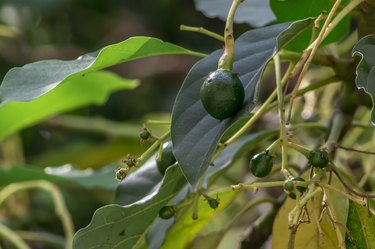
Before an avocado (Persea americana) tree can produce those luscious fruits, it must first produce flowers. Depending on the type, an avocado tree may start to bloom as early in the year as January or as late as April. Even then, only the fertilized flowers can produce fruit, which won't mature until five to 15 months later, depending on the type of avocado tree.
Another factor influencing avocado fruit production is the age and propagation method of a tree. Some avocado trees start bearing fruit when they're youngsters of only 1 year old, while other trees may not produce until they're 13 years of age or older. Most avocado trees are only winter-hardy in U.S. Department of Agriculture plant hardiness zones 10 through 12, although some cultivars, such as Persea americana 'Mexicola,' are hardy to zone 9.
Video of the Day
Video of the Day
Tip
Depending on the type of avocado tree, flowers appear from January through April on plants that are as young as a year old up to 13 (or more) years old.
Avocado Tree Age Influences Blooming
Although starting an avocado tree from seed is easy, seed-started plants take much longer to produce flowers and fruits than grafted trees. It can take anywhere from five to 13 years before a seed-started avocado tree begins to flower and produce fruit. When they finally start producing, avocado trees that are started from seed bear fruits that can be very different in quality and flavor than the original fruit from which the seed came.
A grafted avocado tree typically takes only three to four years to start flowering and fruiting after you plant it. One speedy exception is the Wurtz avocado (Persea americana 'Little Cado'), which begins to produce fruit from one to two years after planting when given optimal growing conditions. As a true dwarf, Little Cado is perfect for containers because it reaches only 10 feet tall, compared to the mature height of 80 feet that's common to most avocado trees. To grow a healthy Little Cado plant, use a large planter (square planters are more stable in windy areas than round ones) filled with loose potting mix and apply avocado fertilizer according to the label directions.
Bloom Sequence of Avocado Flowers
Mature avocado trees have clusters of tiny greenish-yellow flowers with an unusual and interesting blooming pattern. Flowers on Type A avocado trees open in the morning as female blooms and close later that morning or early in the afternoon that same day. In the afternoon of the following day, these same flowers open as male blooms. Flowers on Type B avocado trees open as female in the afternoon, but they close later that afternoon and reopen as male blooms the next morning.
With such precise timing of the opening and closing of the flowers and the corresponding short windows for pollination, it's no wonder that less than 1 percent of the flowers on an avocado tree actually become fertilized, resulting in fruit formation. Some examples of Type A cultivars with heavy fruit set include 'Lula' and 'Meya,' and Type B cultivars with heavy fruit set include 'Hardee' and 'Monroe.'
Avocado Annual Bloom Times
Avocado trees are classified into three groups, or "races," which include Guatemalan, Mexican, and West Indian races. Defining categories of these groups include place of origin, blooming season, maturity season, and fruit characteristics. Mexican avocados begin blooming earlier in the year (January through February), West Indians bloom next (February through March) and Guatemalan groups bloom last (March through April).
Most of the commercial avocado trees in California, which supply 95 percent of the U.S. crop, are from the Guatemalan group, including 'Haas' and 'Fuerte.' These fruits have the familiar pebbly skins, with 'Haas' totaling 80 percent of the commercial avocado production in California.